towing CHEVROLET MALIBU 2007 6.G Owners Manual
[x] Cancel search | Manufacturer: CHEVROLET, Model Year: 2007, Model line: MALIBU, Model: CHEVROLET MALIBU 2007 6.GPages: 510, PDF Size: 2.8 MB
Page 1 of 510
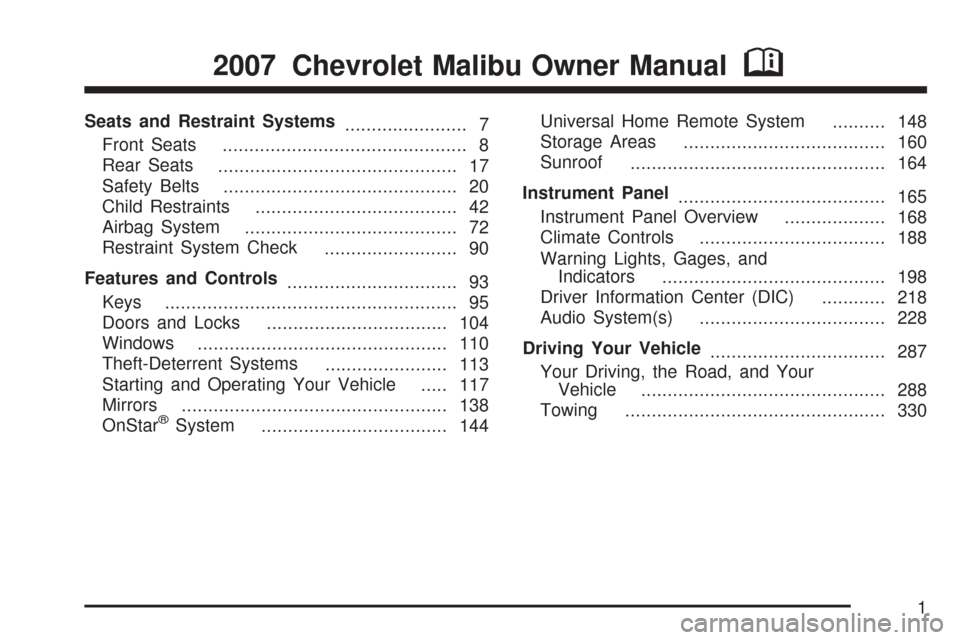
Seats and Restraint Systems
....................... 7
Front Seats
.............................................. 8
Rear Seats
............................................. 17
Safety Belts
............................................ 20
Child Restraints
...................................... 42
Airbag System
........................................ 72
Restraint System Check
......................... 90
Features and Controls
................................ 93
Keys
....................................................... 95
Doors and Locks
.................................. 104
Windows
............................................... 110
Theft-Deterrent Systems
....................... 113
Starting and Operating Your Vehicle
..... 117
Mirrors
.................................................. 138
OnStar
®System
................................... 144Universal Home Remote System
.......... 148
Storage Areas
...................................... 160
Sunroof
................................................ 164
Instrument Panel
....................................... 165
Instrument Panel Overview
................... 168
Climate Controls
................................... 188
Warning Lights, Gages, and
Indicators
.......................................... 198
Driver Information Center (DIC)
............ 218
Audio System(s)
................................... 228
Driving Your Vehicle
................................. 287
Your Driving, the Road, and Your
Vehicle
.............................................. 288
Towing
................................................. 330
2007 Chevrolet Malibu Owner ManualM
1
Page 87 of 510
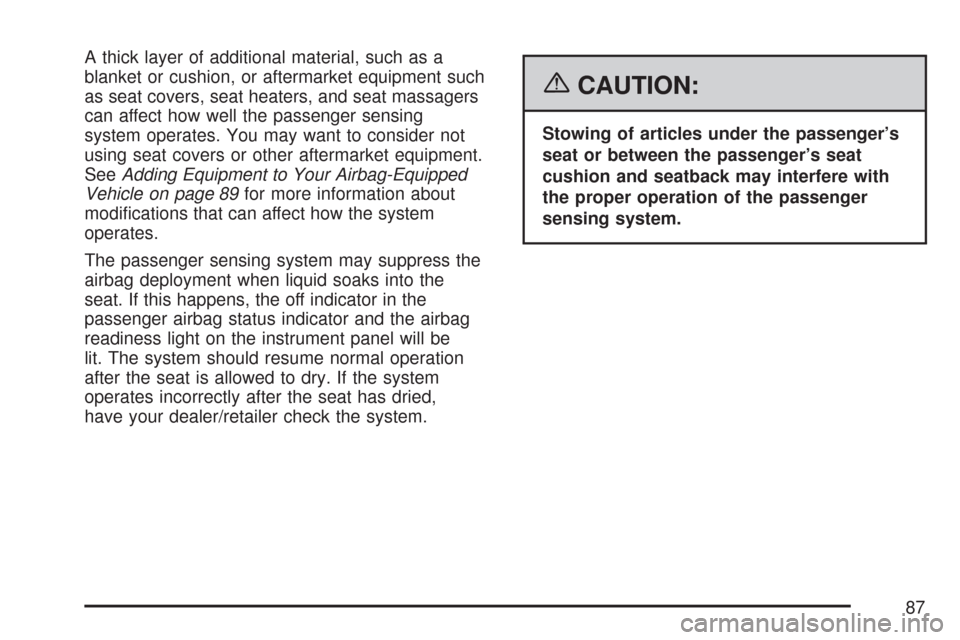
A thick layer of additional material, such as a
blanket or cushion, or aftermarket equipment such
as seat covers, seat heaters, and seat massagers
can affect how well the passenger sensing
system operates. You may want to consider not
using seat covers or other aftermarket equipment.
SeeAdding Equipment to Your Airbag-Equipped
Vehicle on page 89for more information about
modi�cations that can affect how the system
operates.
The passenger sensing system may suppress the
airbag deployment when liquid soaks into the
seat. If this happens, the off indicator in the
passenger airbag status indicator and the airbag
readiness light on the instrument panel will be
lit. The system should resume normal operation
after the seat is allowed to dry. If the system
operates incorrectly after the seat has dried,
have your dealer/retailer check the system.
{CAUTION:
Stowing of articles under the passenger’s
seat or between the passenger’s seat
cushion and seatback may interfere with
the proper operation of the passenger
sensing system.
87
Page 117 of 510
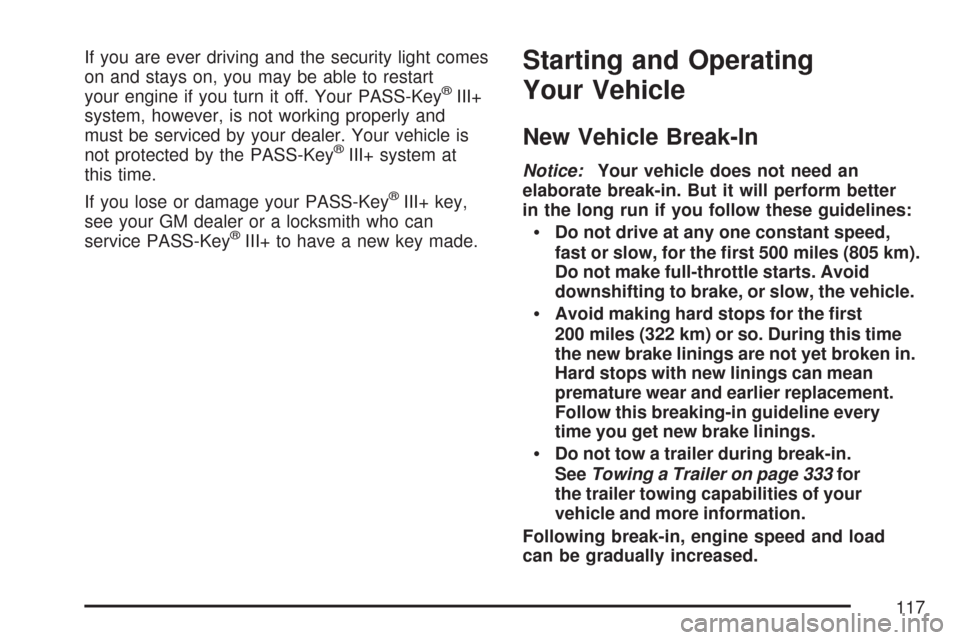
If you are ever driving and the security light comes
on and stays on, you may be able to restart
your engine if you turn it off. Your PASS-Key
®III+
system, however, is not working properly and
must be serviced by your dealer. Your vehicle is
not protected by the PASS-Key
®III+ system at
this time.
If you lose or damage your PASS-Key
®III+ key,
see your GM dealer or a locksmith who can
service PASS-Key
®III+ to have a new key made.
Starting and Operating
Your Vehicle
New Vehicle Break-In
Notice:Your vehicle does not need an
elaborate break-in. But it will perform better
in the long run if you follow these guidelines:
Do not drive at any one constant speed,
fast or slow, for the �rst 500 miles (805 km).
Do not make full-throttle starts. Avoid
downshifting to brake, or slow, the vehicle.
Avoid making hard stops for the �rst
200 miles (322 km) or so. During this time
the new brake linings are not yet broken in.
Hard stops with new linings can mean
premature wear and earlier replacement.
Follow this breaking-in guideline every
time you get new brake linings.
Do not tow a trailer during break-in.
SeeTowing a Trailer on page 333for
the trailer towing capabilities of your
vehicle and more information.
Following break-in, engine speed and load
can be gradually increased.
117
Page 118 of 510
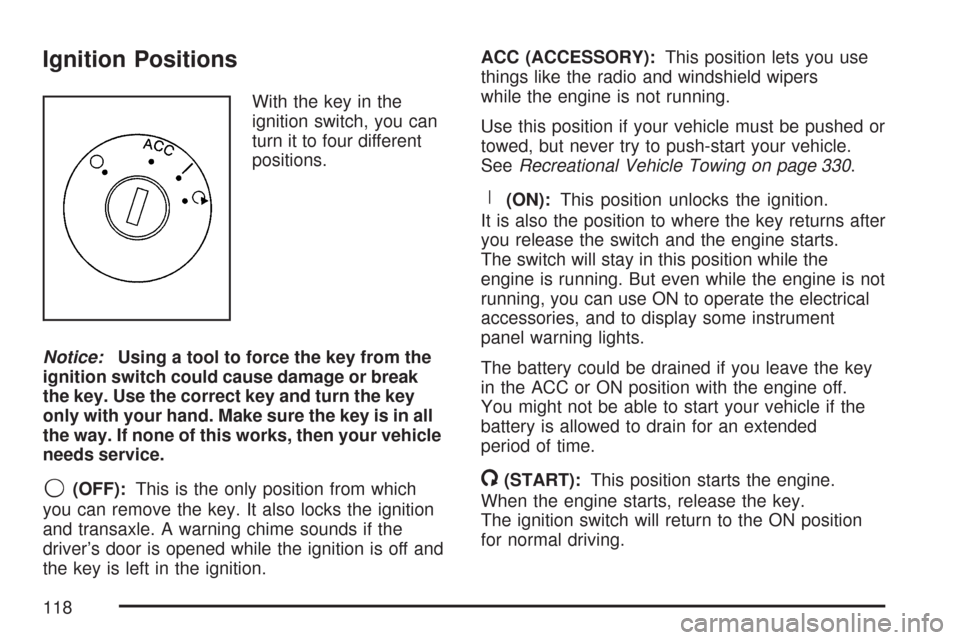
Ignition Positions
With the key in the
ignition switch, you can
turn it to four different
positions.
Notice:Using a tool to force the key from the
ignition switch could cause damage or break
the key. Use the correct key and turn the key
only with your hand. Make sure the key is in all
the way. If none of this works, then your vehicle
needs service.
9(OFF):This is the only position from which
you can remove the key. It also locks the ignition
and transaxle. A warning chime sounds if the
driver’s door is opened while the ignition is off and
the key is left in the ignition.ACC (ACCESSORY):This position lets you use
things like the radio and windshield wipers
while the engine is not running.
Use this position if your vehicle must be pushed or
towed, but never try to push-start your vehicle.
SeeRecreational Vehicle Towing on page 330.
R(ON):This position unlocks the ignition.
It is also the position to where the key returns after
you release the switch and the engine starts.
The switch will stay in this position while the
engine is running. But even while the engine is not
running, you can use ON to operate the electrical
accessories, and to display some instrument
panel warning lights.
The battery could be drained if you leave the key
in the ACC or ON position with the engine off.
You might not be able to start your vehicle if the
battery is allowed to drain for an extended
period of time.
/(START):This position starts the engine.
When the engine starts, release the key.
The ignition switch will return to the ON position
for normal driving.
118
Page 124 of 510
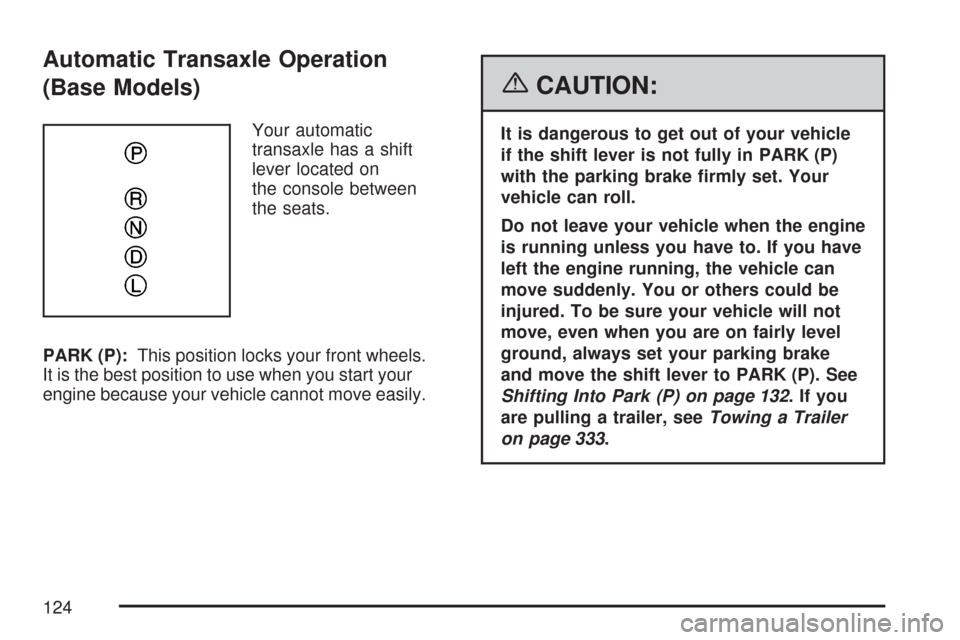
Automatic Transaxle Operation
(Base Models)
Your automatic
transaxle has a shift
lever located on
the console between
the seats.
PARK (P):This position locks your front wheels.
It is the best position to use when you start your
engine because your vehicle cannot move easily.
{CAUTION:
It is dangerous to get out of your vehicle
if the shift lever is not fully in PARK (P)
with the parking brake �rmly set. Your
vehicle can roll.
Do not leave your vehicle when the engine
is running unless you have to. If you have
left the engine running, the vehicle can
move suddenly. You or others could be
injured. To be sure your vehicle will not
move, even when you are on fairly level
ground, always set your parking brake
and move the shift lever to PARK (P). See
Shifting Into Park (P) on page 132.Ifyou
are pulling a trailer, seeTowing a Trailer
on page 333.
124
Page 128 of 510
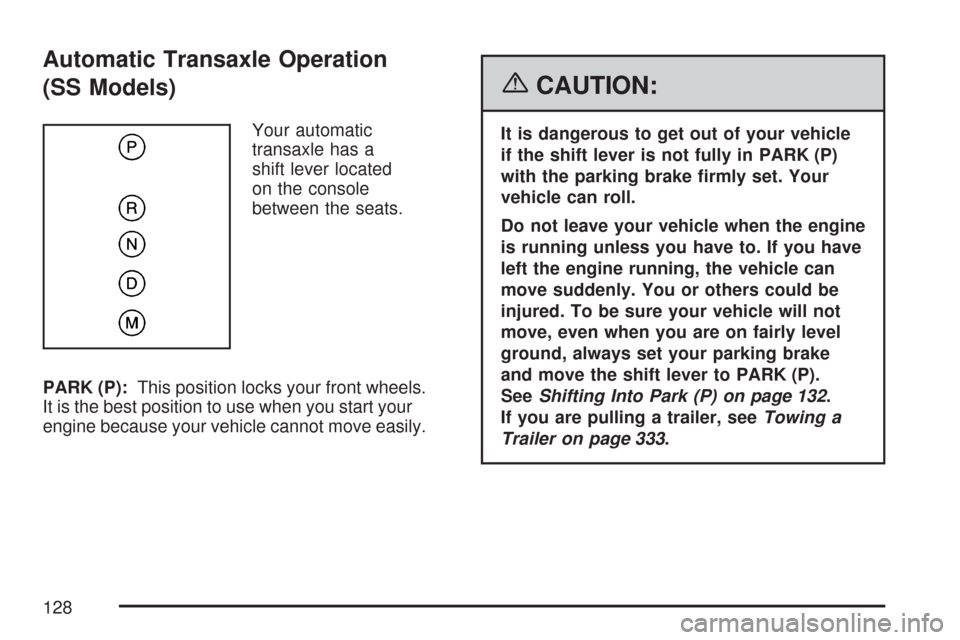
Automatic Transaxle Operation
(SS Models)
Your automatic
transaxle has a
shift lever located
on the console
between the seats.
PARK (P):This position locks your front wheels.
It is the best position to use when you start your
engine because your vehicle cannot move easily.
{CAUTION:
It is dangerous to get out of your vehicle
if the shift lever is not fully in PARK (P)
with the parking brake �rmly set. Your
vehicle can roll.
Do not leave your vehicle when the engine
is running unless you have to. If you have
left the engine running, the vehicle can
move suddenly. You or others could be
injured. To be sure your vehicle will not
move, even when you are on fairly level
ground, always set your parking brake
and move the shift lever to PARK (P).
SeeShifting Into Park (P) on page 132.
If you are pulling a trailer, seeTowing a
Trailer on page 333.
128
Page 132 of 510
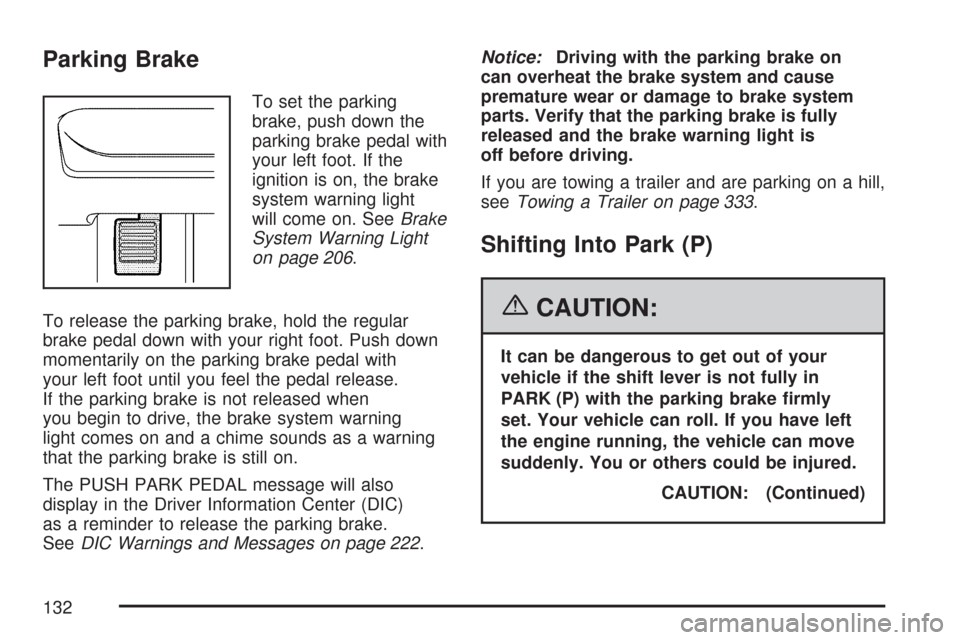
Parking Brake
To set the parking
brake, push down the
parking brake pedal with
your left foot. If the
ignition is on, the brake
system warning light
will come on. SeeBrake
System Warning Light
on page 206.
To release the parking brake, hold the regular
brake pedal down with your right foot. Push down
momentarily on the parking brake pedal with
your left foot until you feel the pedal release.
If the parking brake is not released when
you begin to drive, the brake system warning
light comes on and a chime sounds as a warning
that the parking brake is still on.
The PUSH PARK PEDAL message will also
display in the Driver Information Center (DIC)
as a reminder to release the parking brake.
SeeDIC Warnings and Messages on page 222.Notice:Driving with the parking brake on
can overheat the brake system and cause
premature wear or damage to brake system
parts. Verify that the parking brake is fully
released and the brake warning light is
off before driving.
If you are towing a trailer and are parking on a hill,
seeTowing a Trailer on page 333.
Shifting Into Park (P)
{CAUTION:
It can be dangerous to get out of your
vehicle if the shift lever is not fully in
PARK (P) with the parking brake �rmly
set. Your vehicle can roll. If you have left
the engine running, the vehicle can move
suddenly. You or others could be injured.
CAUTION: (Continued)
132
Page 133 of 510
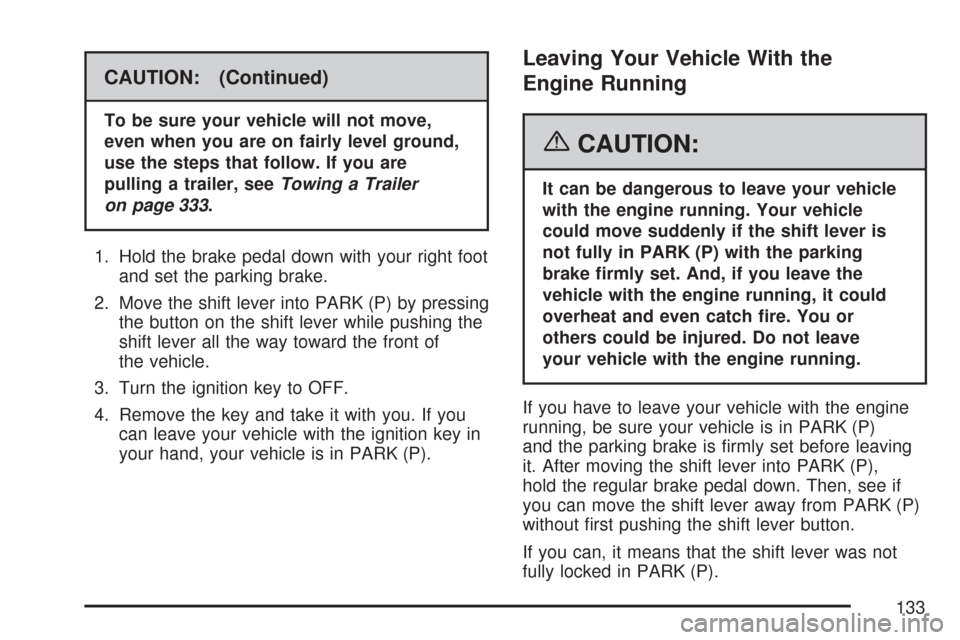
CAUTION: (Continued)
To be sure your vehicle will not move,
even when you are on fairly level ground,
use the steps that follow. If you are
pulling a trailer, seeTowing a Trailer
on page 333.
1. Hold the brake pedal down with your right foot
and set the parking brake.
2. Move the shift lever into PARK (P) by pressing
the button on the shift lever while pushing the
shift lever all the way toward the front of
the vehicle.
3. Turn the ignition key to OFF.
4. Remove the key and take it with you. If you
can leave your vehicle with the ignition key in
your hand, your vehicle is in PARK (P).
Leaving Your Vehicle With the
Engine Running
{CAUTION:
It can be dangerous to leave your vehicle
with the engine running. Your vehicle
could move suddenly if the shift lever is
not fully in PARK (P) with the parking
brake �rmly set. And, if you leave the
vehicle with the engine running, it could
overheat and even catch �re. You or
others could be injured. Do not leave
your vehicle with the engine running.
If you have to leave your vehicle with the engine
running, be sure your vehicle is in PARK (P)
and the parking brake is �rmly set before leaving
it. After moving the shift lever into PARK (P),
hold the regular brake pedal down. Then, see if
you can move the shift lever away from PARK (P)
without �rst pushing the shift lever button.
If you can, it means that the shift lever was not
fully locked in PARK (P).
133
Page 137 of 510
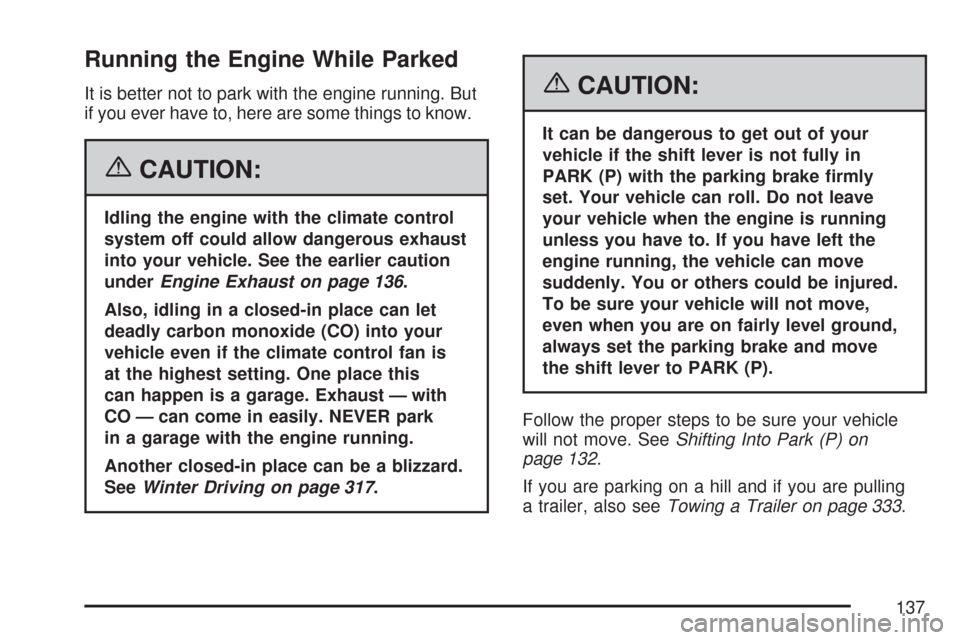
Running the Engine While Parked
It is better not to park with the engine running. But
if you ever have to, here are some things to know.
{CAUTION:
Idling the engine with the climate control
system off could allow dangerous exhaust
into your vehicle. See the earlier caution
underEngine Exhaust on page 136.
Also, idling in a closed-in place can let
deadly carbon monoxide (CO) into your
vehicle even if the climate control fan is
at the highest setting. One place this
can happen is a garage. Exhaust — with
CO — can come in easily. NEVER park
in a garage with the engine running.
Another closed-in place can be a blizzard.
SeeWinter Driving on page 317.
{CAUTION:
It can be dangerous to get out of your
vehicle if the shift lever is not fully in
PARK (P) with the parking brake �rmly
set. Your vehicle can roll. Do not leave
your vehicle when the engine is running
unless you have to. If you have left the
engine running, the vehicle can move
suddenly. You or others could be injured.
To be sure your vehicle will not move,
even when you are on fairly level ground,
always set the parking brake and move
the shift lever to PARK (P).
Follow the proper steps to be sure your vehicle
will not move. SeeShifting Into Park (P) on
page 132.
If you are parking on a hill and if you are pulling
a trailer, also seeTowing a Trailer on page 333.
137
Page 207 of 510
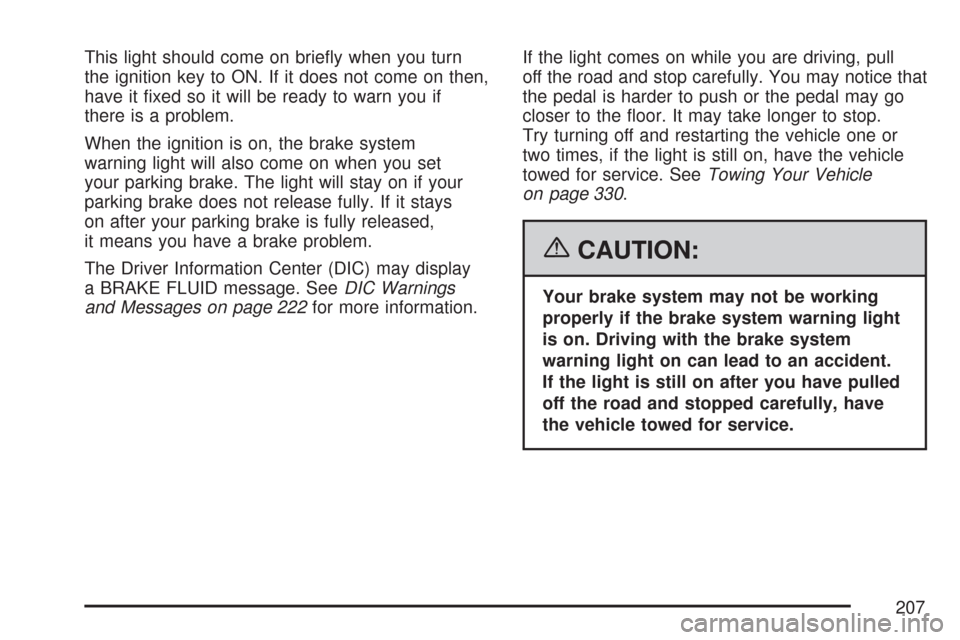
This light should come on brie�y when you turn
the ignition key to ON. If it does not come on then,
have it �xed so it will be ready to warn you if
there is a problem.
When the ignition is on, the brake system
warning light will also come on when you set
your parking brake. The light will stay on if your
parking brake does not release fully. If it stays
on after your parking brake is fully released,
it means you have a brake problem.
The Driver Information Center (DIC) may display
a BRAKE FLUID message. SeeDIC Warnings
and Messages on page 222for more information.If the light comes on while you are driving, pull
off the road and stop carefully. You may notice that
the pedal is harder to push or the pedal may go
closer to the �oor. It may take longer to stop.
Try turning off and restarting the vehicle one or
two times, if the light is still on, have the vehicle
towed for service. SeeTowing Your Vehicle
on page 330.
{CAUTION:
Your brake system may not be working
properly if the brake system warning light
is on. Driving with the brake system
warning light on can lead to an accident.
If the light is still on after you have pulled
off the road and stopped carefully, have
the vehicle towed for service.
207